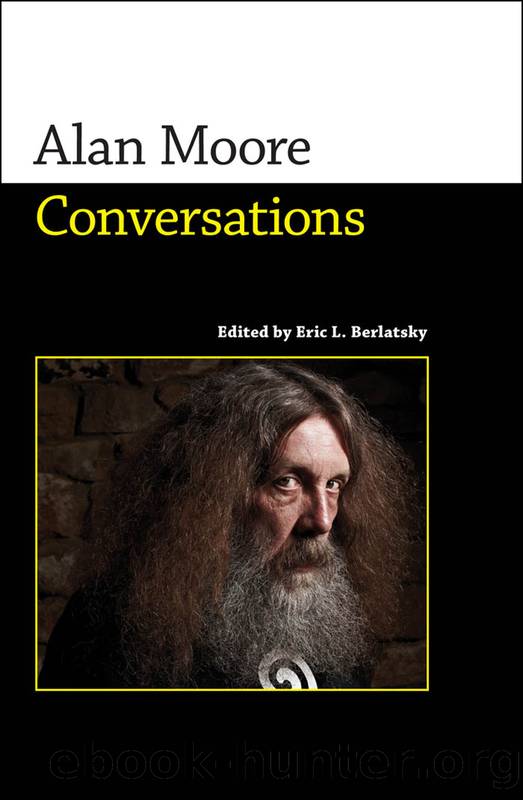Alan Moore by Eric L. Berlatsky

Author:Eric L. Berlatsky
Language: eng
Format: epub
Publisher: University Press of Mississippi
Published: 2012-07-14T16:00:00+00:00
The Craft: An Interview with Alan Moore
DANIEL WHISTON, DAVID RUSSELL, AND ANDY FRUISH / 2002
Zarjaz 3 & 4 (2002–2003). Interview conducted on September 9 and October 29, 2002. Reprinted by permission of Daniel Whiston. Only part one is reprinted here.
PART ONE: SEPTEMBER 9, 2002
Having been graciously invited to his Northampton abode by the World’s Greatest Comics Writer, myself (Daniel Whiston), along with David Russell and Andy Fruish had a long and fascinating meeting with the Enlightened One, surrounded as we were by shelves groaning under the weight of books and comics, walls covered with mystic paraphernalia from throughout the ages, and a constant fug of smoke. Having introduced ourselves (and established that the Dictaphone was indeed working), an intense two-hour introduction to Alan’s methods, opinions and writing approach followed . . .
DW: I feel quite awkward doing this ’cos I’ve never really interviewed anyone before . . .
AM: Well, I’m a doddle for interviewing ’cos I’m completely infatuated with the sound of me own voice. You just have to say a few basic words, and I’ll talk for the next hour or two. You prod me if you want me to stop or change to a different subject.
DW: The selfish motivation for me doing this is that I’m starting to try and write myself and would be really interested to get the benefit of your experience. So from that point of view, I’d be really interested in talking about the mechanics of the craft, and then maybe go on to talk about the higher-level creative aspects in a little bit.
AM: OK.
DW: So maybe we could start off with the nuts and bolts. What’s your approach to plotting, for example?
AM: My approach to most things has been in a state of flux and has been developing over the last twenty-five years that I’ve been working at this. With regard to plotting for example, when I started out with this, I was living in a state of such terror that I would get to the end of a story and not have an ending for it, or would not have at least a satisfactory ending for it, that I would plot my stories out almost to the finest detail. If I was plotting a twenty-four-page Swamp Thing story I would have a kind of rough idea of where I wanted the story to go in my head. I would have perhaps vague ideas of what would make a good opening scene, a good closing scene, perhaps a few muddy bits in the middle. I’d then write the numbers 1 to 24 down the side of the page, and I would put down a one-line description of what was happening on that page. This kind of developed to the point of mania with Big Numbers.
When I plotted Big Numbers, I plotted the entire projected twelve-issue series on one sheet of A1 paper—which was just frightening. A1 is scary—it’s the largest size. I divided it along the top into twelve columns and along the
Download
This site does not store any files on its server. We only index and link to content provided by other sites. Please contact the content providers to delete copyright contents if any and email us, we'll remove relevant links or contents immediately.
| African | Asian |
| Australian & Oceanian | Canadian |
| Caribbean & Latin American | European |
| Jewish | Middle Eastern |
| Russian | United States |
4 3 2 1: A Novel by Paul Auster(11049)
The handmaid's tale by Margaret Atwood(6852)
Giovanni's Room by James Baldwin(5878)
Big Magic: Creative Living Beyond Fear by Elizabeth Gilbert(4723)
Asking the Right Questions: A Guide to Critical Thinking by M. Neil Browne & Stuart M. Keeley(4574)
On Writing A Memoir of the Craft by Stephen King(4213)
Ego Is the Enemy by Ryan Holiday(3991)
Ken Follett - World without end by Ken Follett(3972)
The Body: A Guide for Occupants by Bill Bryson(3801)
Bluets by Maggie Nelson(3710)
Adulting by Kelly Williams Brown(3670)
Guilty Pleasures by Laurell K Hamilton(3586)
Eat That Frog! by Brian Tracy(3514)
White Noise - A Novel by Don DeLillo(3434)
The Poetry of Pablo Neruda by Pablo Neruda(3367)
Alive: The Story of the Andes Survivors by Piers Paul Read(3310)
The Bookshop by Penelope Fitzgerald(3225)
The Book of Joy by Dalai Lama(3217)
Fingerprints of the Gods by Graham Hancock(3212)
